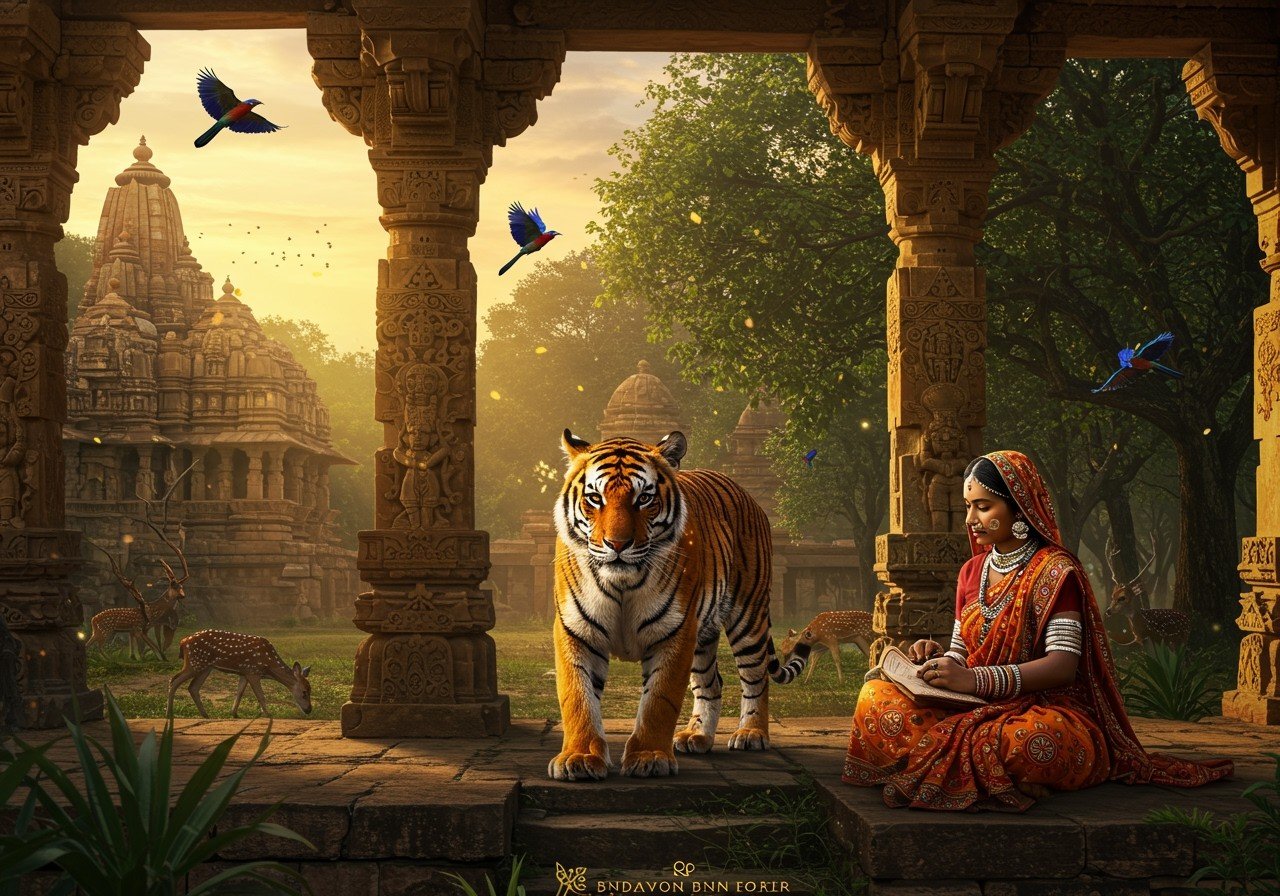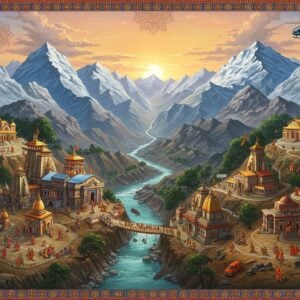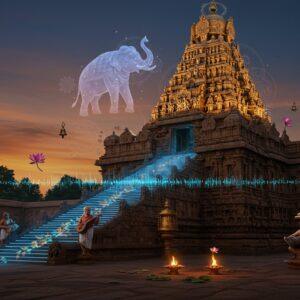
Central India unfolds as a captivating region where nature’s majesty, echoes of history, and vibrant indigenous cultures intertwine. It presents a landscape dotted with lush wildlife reserves, ancient historical monuments, and welcoming tribal communities. This heartland of India invites you on an exploratory journey, offering rich traditions and profoundly authentic experiences.
Wildlife Wonders of the Indian Heartland
The central part of India beckons nature enthusiasts with its incredible biodiversity. This region is renowned for its efforts in wildlife conservation and offers unparalleled opportunities for sightings.
- Kanha National Park: Famous for its significant role in the conservation of the majestic Bengal tiger, Kanha offers sprawling landscapes of sal and bamboo forests. It provides a crucial habitat not just for tigers but also for barasingha (swamp deer) and numerous other species.
- Bandhavgarh National Park: Boasting possibly the highest density of tigers in the world, Bandhavgarh provides thrilling safari experiences. Beyond tigers, the park’s diverse topography supports a rich variety of wildlife and birdlife amidst historical fort ruins.
- Pench National Park: Serving as the inspiration for Rudyard Kipling’s ‘The Jungle Book’, Pench enchants visitors with its unique flora and fauna. Exploring its teak forests offers chances to spot leopards, wild dogs, and diverse bird species, bringing the classic tales to life.
- Satpura National Park: For those seeking a more unique and less crowded wildlife experience, Satpura offers diverse activities like jeep safaris, canoeing, and walking safaris. It’s particularly noted for sightings of sloth bears, leopards, and a variety of lesser-known mammals and birds.
- Panna National Park: Situated along the Ken River, Panna is crucial for the conservation of the endangered Indian vulture and gharial. While recovering its tiger population, it offers scenic beauty and opportunities for boat safaris, adding another dimension to wildlife exploration.
- Tadoba-Andhari Tiger Reserve: Located in neighbouring Maharashtra but often included in Central India tours, Tadoba is another prime destination for tiger sightings, known for its high tiger density and diverse ecosystem.
These vital sanctuaries face ongoing challenges, including habitat fragmentation and human-wildlife conflict. However, dedicated conservation efforts strive to protect this invaluable natural heritage. As visitors, responsible tourism practices are crucial to support these efforts and appreciate the delicate ecological balance.
Journey Through Time: Historical Landmarks
Central India’s historical landscape is as rich and varied as its wildlife. It’s a region where empires rose and fell, leaving behind architectural marvels and stories etched in stone.
- Khajuraho Temples: A UNESCO World Heritage site, the temples of Khajuraho are globally renowned for their intricate sculptures and stunning Nagara-style architecture. These 10th-century temples narrate tales of mythology, celestial beings, and aspects of medieval life.
- Sanchi Stupa: Commissioned by Emperor Ashoka in the 3rd century BCE, the Great Stupa at Sanchi is one of India’s oldest and most significant Buddhist monuments. Its imposing structure and intricately carved gateways (toranas) offer profound insights into early Buddhist art and architecture.
- Mandu: The hill fort of Mandu in Madhya Pradesh is adorned with spectacular Afghan architecture. Its palaces, mosques, and tombs, like the Jahaz Mahal and Roopmati’s Pavilion, whisper romantic tales and showcase the architectural grandeur of bygone eras.
- Gwalior Fort & Palaces: Dominating the city skyline, Gwalior Fort is a magnificent example of medieval Indian architecture. Within its walls lie palaces, temples, and water tanks, reflecting centuries of history and various ruling dynasties.
- Orchha: Nestled on the banks of the Betwa River, Orchha is a hidden gem featuring stunning palaces, temples, and cenotaphs (chhatris). Its well-preserved architecture offers a tranquil journey back to its Bundela Rajput past.
- Ajanta and Ellora Caves: While geographically closer to Western India, these rock-cut cave monuments are often included in broader Central India itineraries. They represent masterpieces of Buddhist, Hindu, and Jain religious art, showcasing incredible craftsmanship.
Visiting these sites offers more than just a glimpse into history; it’s an opportunity to connect with the artistic, spiritual, and royal heritage that has shaped the Indian subcontinent.
Vibrant Threads: The Tribal Cultures of Central India
The indigenous communities are the heart and soul of Central India’s cultural landscape. Regions like Bastar in Chhattisgarh, and areas around the Maikal Hills, are home to diverse tribes such as the Gond, Bhil, Baiga, and the unique Bison-Horn Maria tribe.
Exploring these tribal regions, particularly areas like Kondagaon and Narayanpur, offers invaluable insights into unique traditions, languages, and ways of life. Tribal festivals are vibrant spectacles of music, dance, and rituals, celebrating their connection to nature and ancestral heritage. Gond art, known for its intricate patterns depicting nature and mythology, is a significant cultural export, helping preserve tribal identity in a modernizing world. Interacting respectfully with these communities and supporting local artisans provides a meaningful cultural exchange.
Engaging with tribal culture requires sensitivity and respect. Supporting initiatives that help sustain traditional practices ensures the continuity of this rich cultural mosaic for future generations.
Discovering Hidden Gems: Off the Beaten Path
Beyond the famous parks and monuments, Central India harbours lesser-known destinations offering unique experiences:
- Pachmarhi: Tucked away in the Satpura Range, this hill station captivates visitors with its serene waterfalls, ancient caves (some with prehistoric paintings), and lush green valleys. It offers a peaceful retreat amidst nature.
- Chitrakoot: Steeped in mythological significance related to the Ramayana, Chitrakoot, spanning Uttar Pradesh and Madhya Pradesh border, offers spiritual solace along the Mandakini River, surrounded by natural beauty and numerous temples and ghats. Don’t miss the nearby Chitrakote Waterfalls, often called the ‘Niagara of India’, during monsoon.
- Maheshwar: Situated on the banks of the Narmada River, Maheshwar is famous for its beautiful ghats, historic fort, and exquisite handloom Maheshwari saris. It combines spiritual tranquility with rich craft traditions.
- Omkareshwar: This sacred island, shaped like the holy Hindu symbol ‘Om’, houses one of the 12 Jyotirlinga shrines dedicated to Lord Shiva. It’s a significant pilgrimage site offering spiritual reflection and scenic river views. For deeper insights, explore our Complete Guide to Omkareshwar Jyotirlinga.
- Amarkantak: Considered a holy town, Amarkantak is the source of the Narmada and Sone rivers. Surrounded by forests and hills, it is dotted with ancient temples and offers a serene atmosphere for pilgrims and nature lovers.
- Kanger Valley National Park: Located near Jagdalpur in the Bastar region, this park features stunning limestone caves (Kutumsar and Kailash), the beautiful Tirathgarh Waterfalls, and rich biodiversity.
A Taste of the Region: Central Indian Cuisine
The culinary landscape of Central India reflects its cultural and geographical diversity. In Madhya Pradesh, dishes like ‘Bhutte ki Kees’ (a savory grated corn preparation) and ‘Dal Bafla’ (wheat balls served with lentils) are local favourites. ‘Poha’, flattened rice often tempered with spices and served with sev, is a ubiquitous and beloved breakfast item across the region.
Tribal cuisines introduce unique ingredients like nutritious mahua flowers (used in various preparations, including local brews) and versatile bamboo shoots. Cities like Bhopal exhibit Mughlai influences in their rich non-vegetarian dishes and aromatic biryanis. Exploring local markets and food stalls is the best way to savor these authentic flavours and traditional delights.
Sacred Connections: Poojn’s Support for Your Central India Journey
As you explore the rich tapestry of Central India—its wildlife sanctuaries, revered historical sites, and deep-rooted tribal cultures—Poojn.in enhances your spiritual connection to these places. We provide authentic ritual items and religious supplies, allowing you to engage respectfully with local traditions.
Many temples and sacred spots you’ll encounter are dedicated to deities integral to Hindu traditions. For instance, before visiting sites dedicated to Lord Shiva, a widely revered deity in Central India, consider acquiring items like a Marble Dust Shiva Lingam or Bel Mala beads, traditionally offered to Him. If your journey includes visits to places embodying yogic traditions, an Adiyogi Murti can serve as a meaningful keepsake or offering.
Even connecting with nature in the wildlife sanctuaries can have spiritual undertones, reflecting India’s tradition of seeing the divine in all creation. Enhance your personal devotion with items like a Tulsi Mala, sacred in many Hindu practices.
Related Puja Essentials Available on Poojn.in:
- Traditional puja thalis suitable for temple offerings and home rituals.
- Pure copper items like lotas and plates used in sacred ceremonies.
- Authentic incense (agarbatti) and dhoop to create a pious atmosphere.
- Sacred threads (kalava/moli) and other religious accessories for personal use or offerings.
- Brass and bell metal items like diyas, bells, and idols for worship.
Poojn.in ensures easy access to genuine, high-quality ritual materials that align with local customs, delivered conveniently across India, enriching your exploration of Central India’s diverse heritage.
Embrace the Heart of India
Central India presents an unparalleled fusion of wildlife adventures, historical explorations, cultural immersion, and culinary delights. It’s a journey that takes you through majestic national parks home to tigers and diverse fauna, invites you to walk through ancient forts and temples echoing millennia of history, and connects you with vibrant tribal communities sharing their unique heritage. This region encourages you to venture beyond the familiar, discovering hidden gems that resonate deeply.
Every facet of Central India tells a compelling story. By embarking on this journey, you engage directly with India’s rich legacy. Remember to travel responsibly, respecting the natural environment and local cultures. Your exploration is more than a tour; it’s a chance to honor the past, celebrate the present, and contribute positively to the future of this enchanting heartland. Let the magic of Central India captivate you.
Planning Your Central India Exploration: Common Queries Answered
Embarking on a journey through Central India requires some planning. Understanding the must-visit wildlife sanctuaries is often a priority. Key locations include Kanha, Bandhavgarh, Pench, Satpura, and Tadoba-Andhari Tiger Reserves, each offering unique ecosystems and wildlife viewing opportunities, especially renowned for tiger safaris.
Many travelers seek to explore the rich tribal culture. This can be achieved by visiting regions like Bastar (Chhattisgarh), known for its Gond and Maria tribes, or the areas surrounding the Maikal Hills. Engaging respectfully in local markets (haats), witnessing traditional festivals (if timing aligns), and visiting places like the Anthropological Museum in Jagdalpur offer deep cultural insights. Consider specialised tours like the ‘Wildlife & Tribal Tour of Central India’ that often include interactions with communities in Kawardha or Kanker.
When considering historical sites not to miss, the list is impressive. The UNESCO-listed Khajuraho Temples are world-famous for their artistry. The ancient Sanchi Stupa offers insights into early Buddhist heritage. The fortresses of Gwalior and Mandu showcase magnificent medieval architecture, while the serene temples and palaces of Orchha provide a glimpse into Bundela Rajput history.
Knowing the best time for Central India tourism helps in planning. Generally, the period from October to March offers pleasant weather, ideal for wildlife safaris, sightseeing, and cultural exploration. Summers (April-June) can be very hot, while the monsoon season (July-September) sees park closures and potential travel disruptions, though landscapes are lush.
Guided tours for Central India are readily available and often recommended, especially for first-time visitors or those focusing on specific themes like wildlife or heritage. Operators offer various itineraries, such as ‘Central India Wildlife Safari Tours’ or comprehensive ‘Heritage, Nature & Wildlife Tours’, covering multiple destinations like Delhi, Agra, Khajuraho, and various national parks, often including transport and expert guides.
Wondering what to pack for a trip? Light cotton clothing is suitable for most of the year. For safaris, opt for neutral colours (khaki, beige, green). Pack comfortable walking shoes, a hat, sunglasses, sunscreen, and insect repellent. Binoculars are great for wildlife viewing. During winter months (December-January), bring warm layers for early morning safaris.
Regarding travel within Central India, the region is connected by rail and road. Major cities like Bhopal, Indore, Jabalpur, Nagpur, and Raipur have airports and railway stations. Trains are a common mode for long distances, while buses and hired taxis/cars are used for shorter journeys and reaching specific parks or sites. Road conditions can vary.
Finally, concerning safety, Central India is generally considered safe for tourists. Standard precautions apply: be aware of your surroundings, secure your valuables, respect local customs and traditions (especially dress codes at religious sites), and follow guidelines within national parks. Using reputable tour operators and accommodations enhances safety and travel experience.


